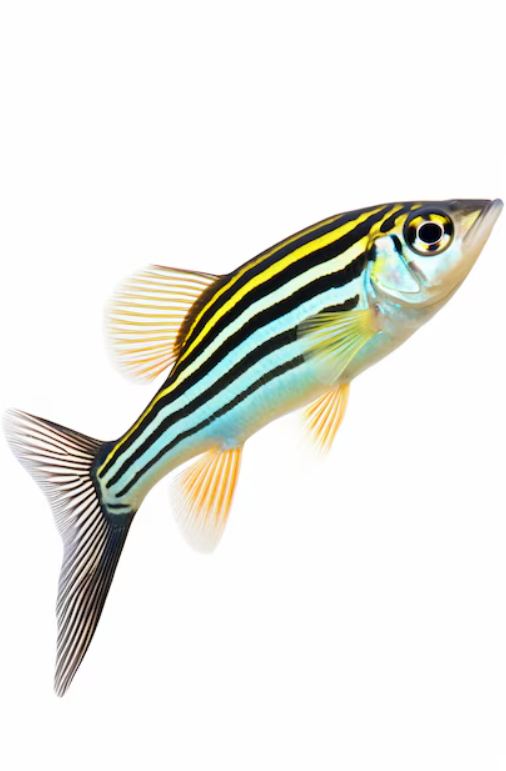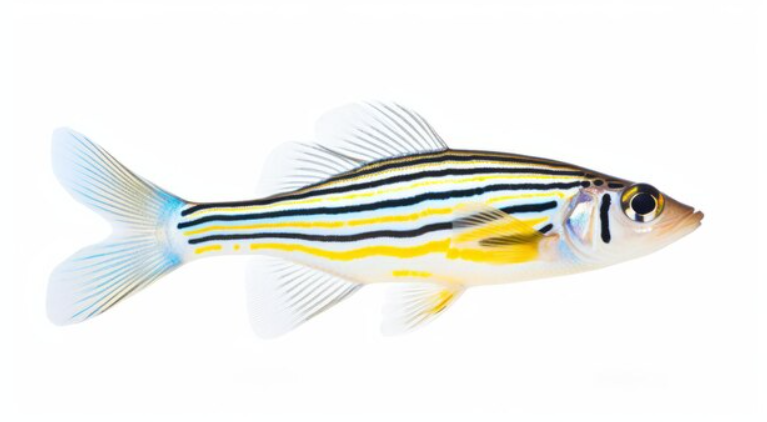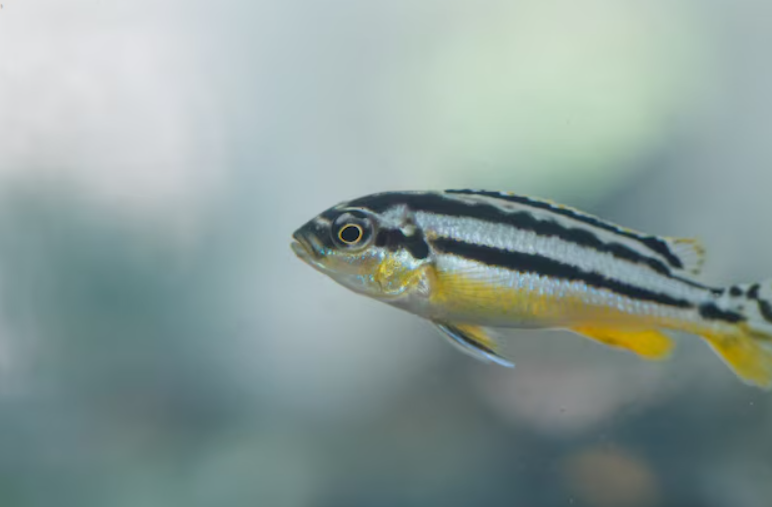
Zebrafish (Danio rerio): An Enchanting Aquarium Fish with Unique Features
The zebrafish (Danio rerio), commonly called the zebrafish, is a small and vibrant freshwater species native to the waters of South Asia. Renowned for its characteristic black-and-white striped pattern, the zebrafish has earned a spot as a top choice among aquarium hobbyists, biologists, and researchers alike. Its reputation for being robust, low maintenance, and highly adaptable makes it an ideal species for both beginners and seasoned aquarists.
The zebrafish is not only a favourite for home aquariums but also a significant player in the realm of scientific studies. Its striking appearance, peaceful demeanour, and ease of care make it a prime option for novice fishkeepers. Beyond its popularity in aquariums, zebrafish have played an instrumental role in advancing research in genetics and medicine, acting as a vital model organism in the study of human biology and diseases. Whether you’re keeping them for pleasure or studying them in a lab, zebrafish offer both educational value and enjoyment.
Yet, zebrafish are more than just a colourful aquarium specimen. Over the years, they have gained considerable recognition in the scientific community due to their pivotal role in genetic research and their utility as a model organism in studies related to human health and disease.
Physical Features of the Zebrafish
Zebrafish are small, streamlined creatures with distinct physical traits that make them easy to recognise:
Size: Adult zebrafish generally reach lengths between 1.5 to 2 inches (3.8 to 5 cm). Despite their petite size, they are energetic swimmers and can often be seen darting swiftly in schools.
Colouration: One of the most distinguishing aspects of zebrafish is their horizontal black-and-white stripes that stretch from the head to the tail. These alternating dark and light bands give them a zebra-like appearance. While the primary purpose of this pattern is camouflage, it also adds to the visual appeal of the fish in home aquariums. Additionally, selective breeding has produced zebrafish in various colour morphs, such as gold, blue, and green.
Body Shape: Zebrafish exhibit a torpedo-shaped body that is built for speed and efficiency in swimming. Their body tapers at both ends, and they have a small, rounded head with large eyes that are easy to spot. The fins are translucent, and the tail fin is forked, helping them navigate the water with precision and agility.
Lifespan: On average, zebrafish live for 2 to 3 years in captivity, though some individuals may live a little longer if given optimal care. This relatively brief lifespan makes them a good choice for those looking to observe the entire lifecycle of a fish.

Native Habitat and Distribution of Zebrafish
Zebrafish are indigenous to South Asia, specifically in countries such as India, Bangladesh, Nepal, and parts of Pakistan. In the wild, they are commonly found in shallow, slow-moving bodies of water, including streams, ponds, rivers, and lakes. These habitats are typically rich in aquatic plants, which offer shelter from predators and provide a plentiful food source for the zebrafish.
The waters in which zebrafish thrive are generally warm, with temperatures ranging between 64°F and 75°F (18°C to 24°C). They also flourish in water with a slightly alkaline pH level, between 6.5 and 7.5. Zebrafish are more inclined to live in calmer waters with low flow, as they prefer well-oxygenated environments with soft to medium hardness levels.
Thanks to their adaptability, zebrafish have been introduced to various regions across the globe, particularly in aquariums, research laboratories, and breeding centres. Their widespread appeal has made them one of the most popular species kept in home aquariums.
Behavior and Social Interactions of Zebrafish
Zebrafish are known for their energetic and social behaviour, making them an entertaining addition to any aquarium setup. Below are some key aspects of their behaviour:
Schooling Behaviour: As natural schooling fish, zebrafish thrive in groups and feel safer when surrounded by others. In the wild, schools help protect them from predators, and in aquariums, they often swim in coordinated groups, darting through the water in unison. Keeping a group of at least 5 to 6 zebrafish will help them feel secure and reduce stress levels.
Peaceful Nature: Zebrafish are generally calm and non-aggressive toward other species, which makes them ideal tank mates for a variety of community fish. However, like many other fish, they may display minor territorial behaviour if the tank is overcrowded. It is best to avoid housing them with overly aggressive species that may cause stress or harm.
Active During the Day: Zebrafish are diurnal creatures, meaning they are active during daylight hours and rest at night. They enjoy swimming energetically, exploring their surroundings, foraging for food, and interacting with others in their group.
Curiosity and Intelligence: Zebrafish are known for their inquisitive nature and intelligence. They are often seen investigating plants, decorations, and the tank’s substrate. Studies have also shown that they can learn and retain tasks, such as navigating mazes, making them fascinating to observe.
Zebrafish Diet and Feeding Preferences
Pellets and Flakes: High-quality pellets and flakes designed for small fish form the core of the zebrafish diet. These specially formulated foods provide a balanced mix of protein, fats, vitamins, and minerals to promote overall health and growth.
Live and Frozen Food: Zebrafish benefit from occasional offerings of live or frozen foods, such as brine shrimp, bloodworms, daphnia, and microworms. These high-protein options aid in healthy growth, reproduction, and vibrancy.
Vegetable Matter: Zebrafish also enjoy plant-based foods. Blanched vegetables, including zucchini, spinach, and lettuce, can be provided as a supplement to their diet. They may also graze on algae or other plant matter present in the tank.
Feeding Schedule: Young zebrafish should be fed 2 to 3 times a day, while adults can be fed once or twice daily. It’s important not to overfeed them, as excess food can pollute the water. Any uneaten food should be promptly removed to prevent water quality issues.
Zebrafish Care Considerations in Captivity
Zebrafish are known for their ease of care, making them a great choice for beginners. However, they do require specific conditions to thrive. Here’s a list of their essential care needs:
Tank Size: A tank size of at least 10 to 20 gallons is recommended for zebrafish, depending on the number of fish. A larger tank will provide ample space for swimming and maintain better water quality. As schooling fish, zebrafish do best when housed in groups.
Water Parameters: Zebrafish prefer slightly alkaline water with a pH between 6.5 and 7.5 and temperatures between 64°F and 75°F (18°C to 24°C). A gentle filter is essential for keeping the water clean and oxygenated, but the flow should not be too strong.
Substrate and Tank Decor: Zebrafish do not have specific substrate requirements, but smooth gravel or sand works well. Adding plants, decorations, and hiding spots to the tank will make the fish feel more secure and provide them with places to explore. Live plants also help maintain good water quality.
Water Quality: Maintaining excellent water quality is crucial for the well-being of zebrafish. Regular water changes of around 25% per week will help maintain stable conditions and remove waste. Monitoring ammonia, nitrite, and nitrate levels is important to ensure the water remains safe.
Lighting: Zebrafish prefer moderate lighting that mimics the natural day-night cycle. A 12-hour light and 12-hour dark period will help maintain their natural rhythm and ensure their health.
Tank Mates: Zebrafish are peaceful and compatible with many other species that share similar water requirements. Good tankmates include neon tetras, guppies, platies, corydoras, catfish, and shrimp. Avoid keeping them with aggressive or fin-nipping fish.
Zebrafish in Scientific Research
Beyond their popularity as aquarium fish, zebrafish have become indispensable in scientific research. Their small size, quick life cycle, and genetic similarities to humans make them ideal subjects for studies in various scientific fields:
Genetics and Development: Zebrafish have been pivotal in researching embryonic development, genetic mutations, and disease mechanisms. The sequencing of their genome has provided invaluable insights into human health, particularly in cancer, heart disease, and neurological disorders.
Drug Testing: Due to their transparent embryos, zebrafish are extensively used in drug screening and toxicity testing, allowing scientists to directly observe the effects of potential medications on living organisms.
Environmental and Toxicology Studies: Zebrafish also play a crucial role in environmental research, helping scientists examine the impact of pollutants and chemicals on aquatic ecosystems.


